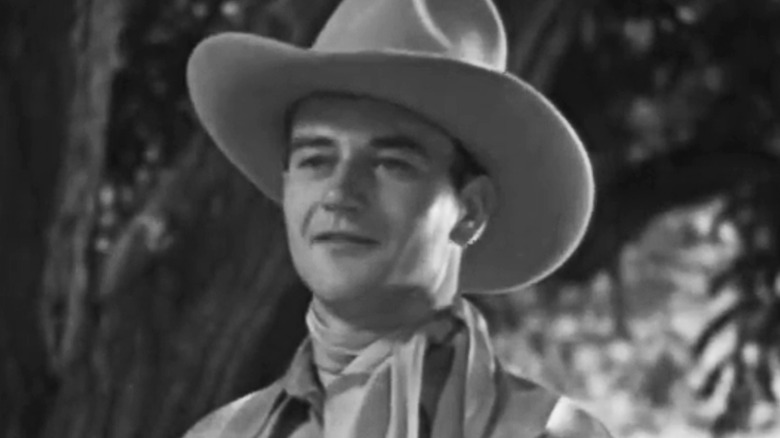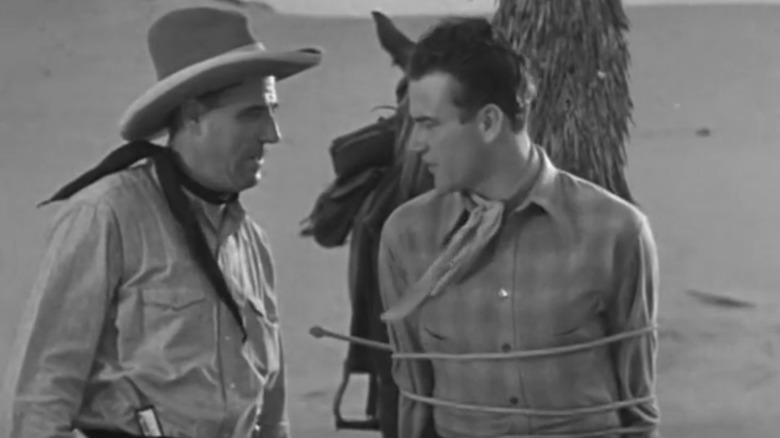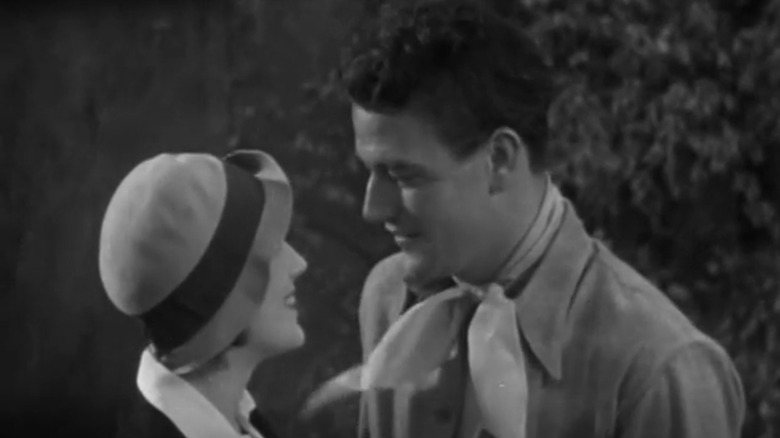John Wayne Was Cast In This Early Western Remake For An Unusual Reason
In our nostalgia-mad monoculture, remakes and reboots are everywhere. But Hollywood has always been in the game of regurgitating existing media, even back in the early 20th century when a young John Wayne was slumming it in B-movie territory. The Duke didn't become a screen icon overnight: He had to pay his dues for a good 10 years, making dozens of what were known as "poverty wow" Westerns — low-budget, low-production-value oaters produced by small studios such as Republic Pictures and Monogram Pictures. Throughout the 1930s, these were the films that gave Wayne his start in Hollywood, before director John Ford rescued him from relative obscurity by casting him in his seminal 1939 Western "Stagecoach" (much to the young actor's surprise).
Prior to breaking through with "Stagecoach," Wayne starred in some of his worst films, including 1933's "The Telegraph Trail," with its unenlightened depiction of Native Americans, and 1934's "'Neath the Arizona Skies," which was one of 13 different projects Wayne fronted that year. But 1932's "Ride Him, Cowboy" is notable for being one of several remakes of earlier silent films starring Ken Maynard.
Directed by Fred Allen, "Ride Him, Cowboy" was at least produced for Warner Brothers rather than any of the poverty row studios. It represents one of six Maynard remakes that were fronted by the Duke between 1932 and 1933, with this particular example being a reworking of a 1926 First National feature called "The Unknown Cavalier."
The talkie version of The Unknown Cavalier was a success
In the late 1920s, sound in film became widespread, leading to an explosion of "talkies." But it also led to an influx of remakes as studios decided to revisit silent projects from years past and bring them into the new age. "Ride Him, Cowboy" was one such example. After Warner Bros. bought First National Pictures, the company had access to the studio's catalog and decided to update some of its silent oaters. But these weren't all going to be complete remakes. In the case of "Ride Him, Cowboy," Warner Bros. chief Jack Warner was convinced to greenlight the project based in large part on the prospect of reusing footage from "The Unknown Cavalier," itself based on Kenneth Perkins' 1923 novel of the same name.
It was this approach that led to a 25-year-old John Wayne being cast in the lead. Evidently, studio execs thought the young actor resembled Ken Maynard enough that audiences wouldn't be able to tell when they intercut their new footage with old scenes of Maynard's stunt work. Even the movie's primary horse was a doppelganger of Tarzan, Maynard's steed from "The Unknown Cavalier."
In the remake, John Wayne plays cowboy John Drury, who arrives in a new town where he saves a horse from being executed. Drury is hailed as a hero by the townspeople, who encourage him to look into a series of criminal acts by a mysterious figure known as The Hawk. Soon, Drury discovers that the seemingly decent Henry Simms (Frank Hagney) is actually The Hawk, who ties Drury to a post before framing him for raiding a ranch and killing a man. After Wayne's cowboy escapes, he has to clear his name and take down the real Hawk before it's too late. Though John Drury isn't one of Wayne's best roles, the film itself was commercially and critically successful, with reviewers praising the remake for its story and cast and Warner reporting a solid profit. But the question we so often ask ourselves today applied back in 1932: Was this remake necessary?
Ride Him, Cowboy was an unnecessary remake that still made sense
If a studio remade a movie today using action scenes from the original and simply intercut new footage into the narrative, it would rightly be dismissed as a cynical cash grab. What's more, Ken Maynard was still appearing in movies at the time Warner Bros. remade "The Unknown Cavalier," which was surely a bit of an insult to the veteran Western star. (That said, Maynard was under contract with Universal at the time, making it impossible for Warners to bring him back for their remake.) What's more, the advent of sound in movies was such a groundbreaking development that it arguably made a lot of sense to remake even relatively recent features if it meant they would finally get a soundtrack.
Doing so certainly seemed to work for Warner Bros. since "Ride Him, Cowboy" proved successful by nearly every metric. Variety (via Turner Classic Movies) reviewed the film favorably, dubbing it "excellent western entertainment" and praising the cast for being "far superior to the usual galaxy in pictures of this type." The outlet also praised the film for having "more story than hard riding," which was a rarity among these types of Western productions at the time. The genre in general had fallen out of favor with audiences, and it was only with "Stagecoach" and several other influential Westerns in 1939 that it regained its popularity. As such, "Ride Him, Cowboy" was never going to be a mega-hit that reinvigorated the Western, though it is a fascinating piece of Hollywood history — and not just for its status as a dodgy talkie remake of a silent movie. In fact, given how well it was received at the time, one could argue it's an underrated John Wayne movie that's worth a watch.


